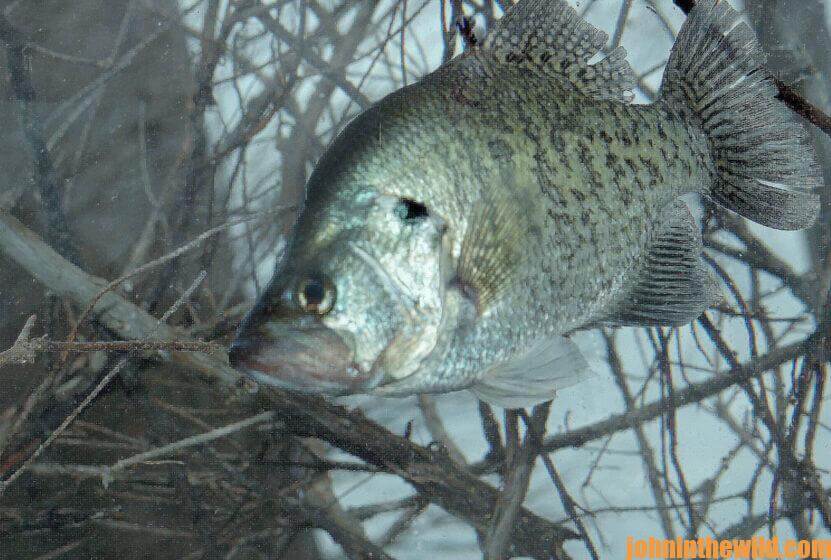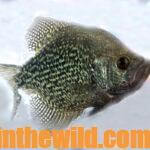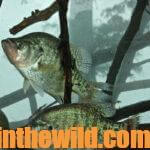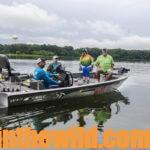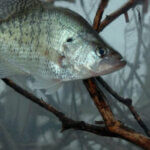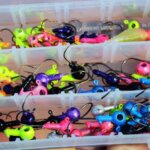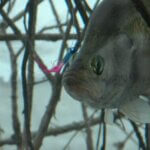Editor’s Note: Tony Adams (Facebook: https://www.facebook.com/tony.adams.5477; Email: [email protected], Phone: 334-695-3003) is a top-notch crappie guide on Alabama’s Lake Eufaula. Lake Eufaula forms the boundary line between the states of Georgia and Alabama, with Lake Eufaula known as Walter F. George Reservoir in Georgia. The springtime tactics for crappie at Lake Eufaula will work at other places in the U.S.
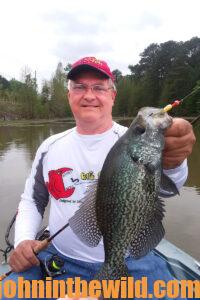 Tony Adams says, “Most crappie are near the banks in shallow water in the spring. However, I’ve learned that during the spring of the year, I also can catch crappie in 30 feet of water; at 25-feet deep; 15-feet deep; right at the bottom and along the banks. But in the past year, I’ve caught springtime crappie more often in deep water than shallow water.”
Tony Adams says, “Most crappie are near the banks in shallow water in the spring. However, I’ve learned that during the spring of the year, I also can catch crappie in 30 feet of water; at 25-feet deep; 15-feet deep; right at the bottom and along the banks. But in the past year, I’ve caught springtime crappie more often in deep water than shallow water.”
One thing that’s certain every year is that during March and April, cold fronts and warm fronts will move through southern states intermittently. So, crappie are often on the move from shallow water, where they plan to spawn when the weather warms-up, and then return to deep water, when a cold front hits.
Another factor that causes crappie to be caught in deep water during the spring of the year is that not all of the crappie in a lake or a river go to the banks to spawn at the same time. Crappie move in and out of shallow water at different times of the year. For instance, a crappie may go onto the banks to spawn several times from the end of February through the end of April, depending on where the river or the lake is located, how much shallow water the river or the lake has available, and what variety of crappie are spawning. Generally, but not absolutely, is the fact that black crappie usually will spawn first – with white crappie moving into the shallows a week to three weeks later.
 Like many other lakes, Lake Eufaula is black crappie and white crappie dominant. However, another type of crappie that’s primarily seen in Tennessee and Kentucky that has a wide variety of names and features a black streak along the top of its back, is known at Lake Eufaula as a magnolia crappie, a black-back crappie and a stripe-back crappie to distinguish those crappie from the other two varieties.
Like many other lakes, Lake Eufaula is black crappie and white crappie dominant. However, another type of crappie that’s primarily seen in Tennessee and Kentucky that has a wide variety of names and features a black streak along the top of its back, is known at Lake Eufaula as a magnolia crappie, a black-back crappie and a stripe-back crappie to distinguish those crappie from the other two varieties.
“About one out of every 50 crappie at Lake Eufaula will be a black-back,” Adams explains. “This variety of crappie has been in this lake for many years. However, those fish aren’t nearly as dominant as the black crappie or the white crappie in Eufaula.”
“Crappie will hold in a variety of depths in the spring because some crappie will lay all of their eggs and be spawned-out in the early part of the spring. Other crappie may hold their eggs and not move into the shallow water until the later part of the spring. When I’ve been catching crappie at a variety of depths in the spring, some of those crappie will be bulging with eggs. Other fish that are caught that same day will have smaller egg sacks that aren’t fully developed. Still other crappie may not have any eggs in them.
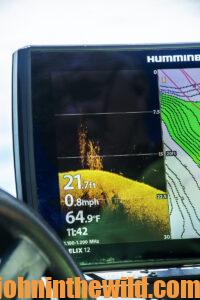 “I’ve learned that water temperature and weather patterns will make crappie pull out of the shallow water and return to deep water when the water temperatures aren’t conducive for spawning. Also, high water and muddy water often will make the crappie pull-out and/or move in to the banks to spawn at different times during the spring. I think the real key here is to remember that all crappie in a river or a lake don’t spawn at the same time, and that’s the reason we can catch them from 30-feet deep to 1-foot deep during the same day in the spring.”
“I’ve learned that water temperature and weather patterns will make crappie pull out of the shallow water and return to deep water when the water temperatures aren’t conducive for spawning. Also, high water and muddy water often will make the crappie pull-out and/or move in to the banks to spawn at different times during the spring. I think the real key here is to remember that all crappie in a river or a lake don’t spawn at the same time, and that’s the reason we can catch them from 30-feet deep to 1-foot deep during the same day in the spring.”
On colder, spring days, Adams has had much more success in fishing the structure of the 25-30 foot deep water. On warmer days, he’ll catch crappie in the 15, 12 and 8 foot deep water. If a warming trend has happened for several consecutive days, he’ll catch them in 1-5 foot deep water. According to Adams, “I’ve also learned that when the water temperature is 65-68 degrees, that’s when fishing the riprap seems to pay the best crappie dividends.”
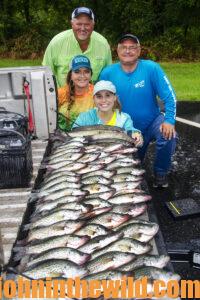 All these factors explain why an angler who knows how to use his depth finder can pinpoint and catch more crappie at various water depths during any day of the spring than a crappie fisherman without a depth finder. Another factor that tends to make Adams consistently successful in catching crappie during the spring is that he puts-out structure in the lake every year during the winter months. He averages sinking from 80-100 types of structure to refurbish crappie hot spots where he’s caught crappie in the past. If the structures seem to have deteriorated over the years, Adams sinks new structures there in several water depths and builds new places to have areas to find and catch crappie all year long.
All these factors explain why an angler who knows how to use his depth finder can pinpoint and catch more crappie at various water depths during any day of the spring than a crappie fisherman without a depth finder. Another factor that tends to make Adams consistently successful in catching crappie during the spring is that he puts-out structure in the lake every year during the winter months. He averages sinking from 80-100 types of structure to refurbish crappie hot spots where he’s caught crappie in the past. If the structures seem to have deteriorated over the years, Adams sinks new structures there in several water depths and builds new places to have areas to find and catch crappie all year long.
A lovely and convenient place to stay at Lake Eufaula right on the water is (https://www.alapark.com/parks/lakepoint-state-park – Office: 334-687-8011)
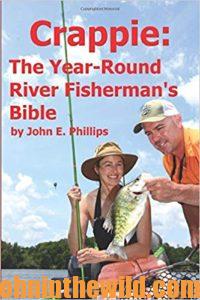 To learn more about crappie fishing, check out John E. Phillips’ book, “Crappie: The Year-Round River Fisherman’s Bible” at https://www.amazon.com/gp/product/B07YDXB4G9/ref=dbs_a_def_rwt_hsch_vapi_taft_p2_i5
To learn more about crappie fishing, check out John E. Phillips’ book, “Crappie: The Year-Round River Fisherman’s Bible” at https://www.amazon.com/gp/product/B07YDXB4G9/ref=dbs_a_def_rwt_hsch_vapi_taft_p2_i5
and available in Kindle, print and Audible. You may have to copy and paste this link into your browser. (When you click on the books, notice on the left where Amazon says you can read and hear 10% of the book for free). On the right side of the page and below the offer for a free Audible trial, you can click on Buy the Audible book.
Tomorrow: Where to Look and What to Fish for Spawning Crappie



